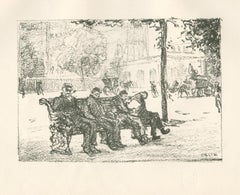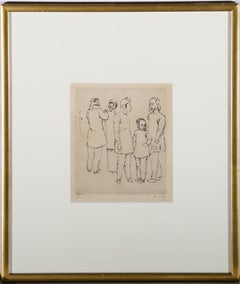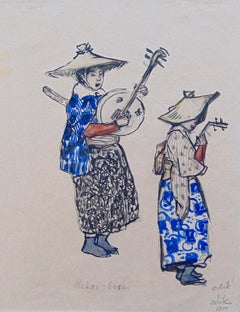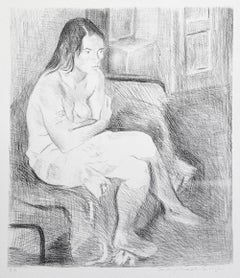Emil Orlik Art
to
5
3
1
2
1
1
4
Overall Height
to
Overall Width
to
2
1
7
4
3
3
3
3
2
2
2
1
1
7
2
2
2
8
6,952
3,302
2,514
1,213
5
2
1
1
1
Artist: Emil Orlik
"In the Park" original lithograph
By Emil Orlik
Located in Henderson, NV
Medium: original lithograph. This Emil Orlik lithograph is also known as "On the Victoria Embankment, London". This impression on wove paper was printed in 1900 and published in Lond...
Category
Early 1900s Emil Orlik Art
Materials
Lithograph
Emil Orlik (1870-1932) - Early 20th Century Etching, Chinese Women
By Emil Orlik
Located in Corsham, GB
A charming etching by 19th century artist Emil Orlik. Etched in Orlik's signature minimalist style, the group of figures appear to be in conversation. Signed in graphite below the pl...
Category
Early 20th Century Emil Orlik Art
Materials
Etching
Chinesische Abende - Vintage Rare Book Illustrated by Emil Orlik - 1920
By Emil Orlik
Located in Roma, IT
Chinesische Abende is an original modern rare book written by Greiner Leo (Brno, 1876 - Berlin, 1928) and illustrated by Emil Orlik (Prague, 1870 – 1932) in 1920.
Published by Reiss...
Category
1920s Emil Orlik Art
Materials
Paper, Lithograph
Hokai-bushi
By Emil Orlik
Located in London, GB
EMIL ORLÍK 1870-1932
Prague 1870 – 1932 Berlin (Czech)
Title: Hokai-bushi, 1900
Technique: Original Hand Signed Watercolour on Wove Paper
Paper size: 20 x 19.3 cm. / 7.9 x 7.6 in....
Category
Early 1900s Modern Emil Orlik Art
Materials
Watercolor
Am Gänsehäufel in Wien
By Emil Orlik
Located in New York, NY
Emil Orlik (1870-1932), Am Gänsehäufel in Wien, 1911, soft-ground etching, signed and dated in pencil lower right. In very good condition, on firm laid paper with margins, 5 1/2 x 8...
Category
1910s Expressionist Emil Orlik Art
Materials
Etching
Portrait of Slevogt
By Emil Orlik
Located in New York, NY
Emil Orlik (1870-1932), Portrait of Slevogt, etching, 1921, signed in pencil and numbered (27/100) [also signed and dated in the plate], from the presumed edition of 100. In very goo...
Category
1920s Realist Emil Orlik Art
Materials
Etching
Market in Grodek
By Emil Orlik
Located in New York, NY
Emil Orlik (1870-1932), Market in Grodek, etching and aquatint, 1898, signed in pencil lower right, in very good condition, trimmed just outside of the platemark and so with a small ...
Category
1890s Expressionist Emil Orlik Art
Materials
Etching, Aquatint
Die Loge im Gaite Montparnasse (Paris)
By Emil Orlik
Located in New York, NY
Emil Orlik (1870-1932), Die Loge im Gaite Montparnasse (Paris), drypoint, etching and soft ground, 1911, signed and numbered in pencil lower right, for the portfolio Zuschauer und Zu...
Category
1910s Emil Orlik Art
Materials
Drypoint, Etching
Related Items
SEATED WOMAN ON BED, KNEE SOCKS Signed Lithograph, Female Portrait Drawing
By Raphael Soyer
Located in Union City, NJ
SEATED WOMAN PINK SOCKS is an original hand drawn (not digitally or photo reproduced) limited edition lithograph by the artist Raphael Soyer - Russian/American Social Realism...
Category
1970s Realist Emil Orlik Art
Materials
Lithograph
S. LOEB (SOLOMON LOEB)
By Anders Zorn
Located in Portland, ME
Zorn, Anders. S. LOEB (SOLOMON LOEB). H&H76, Asplund 115, Delteil 113. Etching, 1897. Unsigned (signed in the plate). Apparently the 2d or 4th State of 4. All of the states are descr...
Category
Late 19th Century Realist Emil Orlik Art
Materials
Etching
Jim Dine Rimbaud, the Coffee Exporter poet portrait drawing in earth tone sepia
By Jim Dine
Located in New York, NY
Jim Dine has expertly sketched the accomplished French poet and coffee trader Arthur Rimbaud. A vignette of dark brown surrounds his thin, fine features, which are defined with a flu...
Category
1970s Realist Emil Orlik Art
Materials
Etching
Rudolf v. Rittner as Florian Geyer - Last man standing -
By Lovis Corinth
Located in Berlin, DE
Lovis Corinth (1858 Tapiau - 1925 Zandvoort), Rudolf von Rittner as Florian Geyer, 1924 (Müller 854), drypoint signed in pencil. 20.4 × 14.2 (plate size), 37.7 × 30.6 cm (sheet size). Published by Karl Nierendorf, Berlin. Framed in a passepartout.
- Strong, precise impression. Frame a little bit rubbed and with two small damages.
About the artwork
The knight is a leitmotif in Lovis Corinth's work, culminating in his Self-Portrait in Armour of 1914. Of all the paintings on this theme, Corinth most often depicted Florian Geyer. Descended from a Franconian noble family, he fought for the freedom of the peasants during the peasant wars of the Reformation, first diplomatically and then militarily, leading the legendary Schwarzen Haufen (Black Troops). The name derives from the black uniforms with which Geyer dressed the peasants willing to fight.
During the Napoleonic occupation, the freedom fighter Florian Geyer was sung about by the Romantics, and the free corps Die Schwarze Schaar, founded in 1813 by Major von Lützow, succeeded the Schwarzer Haufen. It was against this historical background that Gerhard Hauptmann wrote the revolutionary drama Florian Geyer, which premiered at the Deutsches Theater in Berlin in 1896. While the actor Rudolf Rittner, who would later appear in Fritz Lang's films, initially played the role of Schäferhans, he took over the leading role in the new production at Berlin's Lessing Theatre in 1904, again directed by Emil Lessing, which established his fame as an actor. Hauptmann himself praised the acting. He wrote to Hugo von Hofmannsthal: "It went quite well with Florian Geyer. In any case, I had the great pleasure of seeing the play again in an admirable performance". And Lovis Corinth was so taken with Rittner's performance that he painted an oil portrait of him in the role of Florian Geyer in 1906.
After two further graphic versions in 1915 and 1920/21, Corinth returned to the painting a year before his death and almost twenty years after the oil painting to create this graphic version in 1924. Even the inscription in the picture was taken over. This proves all the more the importance of the knight and freedom fighter for Corinth's self-image.
The oil painting, in particular, proclaims the single-minded determination to fight to the last for the values defended, manifested in the oil painting by the tattered flag held out to the enemy. There is a parallel with Rainer Maria Rilke's 1899 story The Cornet, in which the protagonist goes down with the flag that he first saved at the risk of his life.
Consequently, the portrait is also a self-portrait, and the knight's armour is not an academic costume or an ironic refraction, but an expression of Corinth's self-image, which also includes his self-representation as an artist. The Secession poster...
Category
1920s Expressionist Emil Orlik Art
Materials
Etching
Free Shipping
H 8.04 in W 5.6 in
General Wilhelm von Blume - Visionary retrospective -
Located in Berlin, DE
Bernhard Pankok (1872 Münster - 1943 Baierbrunn), General Wilhelm von Blume, 1915, aquatint etching, 34 x 29.5 cm (sheet size), 26 x 22 cm (plate size), signed in the plate at upper left, in pencil at lower right and dated in pencil at lower left.
- At lower left old collection stamp, at the right broad margin with a small spot, otherwise very good condition.
About the artwork
The 1915 aquatint etching of General Wilhelm von Blume is based on a 1912 oil painting in the LWL-Museum für Kunst und Kultur in Münster. A second oil portrait of the general by Pankok is in the Staatsgalerie Stuttgart. When Pankok painted the first oil portrait in 1912, the general had already been retired for 16 years. It is therefore a retrospective portrait. Accordingly, the orientation of his head is such that he is looking back in both the oil painting and the etching. Without fixing on anything in particular, he looks thoughtfully inwards and reflects on his life. Uniformed and highly endowed, it is his military activities in particular that he is reviewing attentively and, as his gaze reveals, quite critically.
Pankok has literally written the sum of his experiences on Wilhelm von Blume's face: The physiognomy is a veritable landscape of folds, furrows, ridges and gullies, all the more striking against the flat background. It is clear that each of the medals was also won through suffering. However, by breaking the boundaries of the picture, his bust appears as an unshakable massif, which gives the general a stoic quality.
The fact that the design of the portrait was important to Pankok can be seen from the different versions, the present sheet being the third and probably final revision, which Pankok dates precisely to 18 February 1915. Compared with the previous state, the light background now has a dark area against which the sitter's face stands out, the dark background in turn combining with the uniform to create a new tension in the picture.
Pankok's taking up of the portrait of the high-ranking military veteran and its graphic reproduction can also be seen in relation to the First World War, which had broken out in the meantime. In the face of modern weapons of mass destruction, Wilhelm von Blume's warfare and military writings were relics of a bygone, more value-oriented era.
About the artist
After studying at the Düsseldorf Art Academy from 1889 to 1891 under Heinrich Lauenstein, Adolf Schill, Hugo Crola, and Peter Janssen the Elder, Bernhard Pankok went to Munich in 1892, where he worked primarily as a graphic artist for the two major Jugendstil magazines "Pan" and "Jugend," which established his artistic success. Through this work he met Emil Orlik, with whom he had a lifelong friendship.
In 1897, he exhibited his first furniture, and in 1898, together with Richard Riemerschmid, Bruno Paul and Hermann Obrist...
Category
1910s Realist Emil Orlik Art
Materials
Etching
H 13.39 in W 11.82 in D 0.4 in
Les Travaux - Lithograph by Robert Lotiron - Early 20th Century
By Robert Lotiron
Located in Roma, IT
Les Travaux is a lithograph realized by Robert Lotiron in the Early 20th Century.
Good condition.
The artwork is depiced through soft strokes in a well-balanced composition.
Category
Mid-20th Century Modern Emil Orlik Art
Materials
Lithograph
H 9.85 in W 12.6 in D 0.08 in
WOMAN LONG DARK HAIR Signed Lithograph, Female Portrait, V-Neck Top, Realism
By Raphael Soyer
Located in Union City, NJ
WOMAN LONG DARK HAIR is an original hand drawn (not digitally or photo reproduced) limited edition lithograph by the artist Raphael Soyer - Russian/American Social Realism...
Category
1970s Realist Emil Orlik Art
Materials
Lithograph
Ancient Roman Fresco Herculaneum - Etching by Carlo Oratij - 18th Century
Located in Roma, IT
Ancient Roman Fresco from the series "Antiquities of Herculaneum", is an etching on paper realized by Carlo Oratij in the 18th Century.
Signed on the plate.
Good conditions.
The e...
Category
Late 18th Century Old Masters Emil Orlik Art
Materials
Etching
H 4.73 in W 9.06 in D 0.08 in
Balaclava - The target in sight -
Located in Berlin, DE
Heinrich Haberl (1869 Passau to 1934 Munich), Sturmhaube, c. 1900. drypoint, 14 x 10 cm (platemark), 28 x 21 cm (sheet size), 39 x 29 cm (passe-partout), titled "Sturmhaube" in lead at lower left and inscribed "Kaltnadelradierung", signed and locally inscribed "Heinrich Haberl Mchn. [Munich]" at lower right, inscribed again in lead on verso and with old collection stamp.
- slightly darkened, fixed and mounted
- The target in sight -
About the artwork
The theatrical "role-portrait" is to be seen against the background of the Rembrandt cult, which reached its climax at the end of the 19th century. The soldier seems to have stepped straight out of Rembrandt's Night Watch (1642) to fix something outside the picture with an alert and ready gaze. The steeply rising brim of the morion frames the gaze and thus perspectivises it as the actual 'pictorial action'. The gaze represents both the vigilant defence and the visionary goal of the battle.
Not only the subject, but also the style of the etching needle reflect Rembrandt's understanding of the times. Strong contrasts of light and dark are created in a virtuoso free stroke, without losing the effect of the reflections on the helmet and in the eyes. This shows a kinship with the early prints of Lovis Corinth, who also saw himself as an artist in the role of the knight. Against this background, Haberl's picture can also be seen as a representation of his artistic self-image.
About the artist
Heinrich Haberl first attended the art school in Nuremberg and from 1892 studied at the Munich Academy. There he was a master student of Johann Leonhard von Raab, Rudolf von Seitz, Franz von Defregger...
Category
Early 19th Century Realist Emil Orlik Art
Materials
Etching
Self Portrait With Children - Original woodcut (Buisson #60.109)
By Leonard Tsuguharu Foujita
Located in Paris, FR
Leonard Tsuguharu FOUJITA
Self Portrait With Children, 1960
Original woodcut
On vellum 37 x 28 cm (c. 15 x 11 in)
REFERENCES : Catalogue Raisonne Sylvie Buisson #60.109
Excellent ...
Category
1960s Realist Emil Orlik Art
Materials
Etching
Free Shipping
H 14.57 in W 11.03 in
Picasso with Woman Head and Faun - Original etching - "Bon a tirer" proof
By Pablo Picasso
Located in Paris, FR
Pablo PICASSO and Paul LEMAGNY
Portrait of Picasso with Woman Head and Faun, 1956
The upper part (portrait of Picasso) is an original etching by Paul Lemagny
The lower part (woman head and faun) is an original etching by Pablo Picasso
Printed signature in the plate
Annotated 9th state and 'Bon à tirer...
Category
1950s Realist Emil Orlik Art
Materials
Etching
Free Shipping
H 19.69 in W 12.8 in
Woman sitting: Hilary Hennes Miller c.1940 English Modern British Art
By Hilary Hennes
Located in London, GB
To see our other Modern British Art, including others by Hennes, scroll down to "More from this Seller" and below it click on "See all from this Seller" - or send us a message if you...
Category
1940s Modern Emil Orlik Art
Materials
Gouache
Emil Orlik art for sale on 1stDibs.
Find a wide variety of authentic Emil Orlik art available for sale on 1stDibs. You can also browse by medium to find art by Emil Orlik in etching, lithograph, aquatint and more. Much of the original work by this artist or collective was created during the 20th century and is mostly associated with the Expressionist style. Not every interior allows for large Emil Orlik art, so small editions measuring 1 inch across are available. Customers who are interested in this artist might also find the work of Carl Otto Czeschka, Max Liebermann, and Karl Michel. Emil Orlik art prices can differ depending upon medium, time period and other attributes. On 1stDibs, the price for these items starts at $150 and tops out at $5,200, while the average work can sell for $636.





